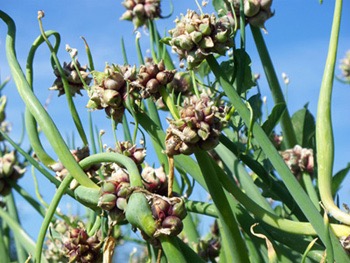EgyptianWalkingOnion

" … still actively aspiring, still learning, preserving the potential for if not better, at least different, later on."
The Muse and I cover the nearly twenty miles down to the Union Station Farmers' Market most summer-ish Saturday mornings, timing our arrival with the opening; easier parking, fewer people, more opportunities to chat with the farmers. Each week, something "new" appears on offer, or something new to me. This week's newby turned out to be Egyptian Walking Onions. I'd never seen them before, so I asked and got a long, nearly scholarly dissertation sprinkled with philosophy. These onions, like all onions, produce 'sets' atop their stalks, Eventually, these sets outweigh the stalks, causing them to fold over, placing the sets in proximity to the ground. There, the sets take root to grow a next generation. Over time, this repeated folding over to grow a next generation can result in the onions "walking" across a field, hence the name. ©2018 by David A. Schmaltz - all rights reserved
These onions aren't much to talk about. Mostly tall green stalk, only a smaller than shallot-sized bulb represents the recognizably onion contingent of the plant; lots of green with very little white, perhaps blushing to violet. They're prone to woodiness. I expect that the tops would make fine braising veg. We didn't buy any of those babies. We chatted about competing strategies for dealing with tough asparagus ends with an asparagus farmer instead. We debated the wisdom of encouraging anyone to sell tomatoes for six bucks a pound, The Muse finally tumbling to the seduction of an early sense of summer. I found a decent baguette. We found pea shoots and some fine peppery lettuces.
The climb up and over the RTD tracks back to our semi-secret parking place always seems like a struggle, though we share the load and did not forget our shade hats. The car's boiling inside, but I remembered to bring the ice chest and the blue ice to keep the tender veg cool while we continue our adventure. No, we're not wearing khaki or pith helmets and we will not leave the dense core of the megalopolis, but we're nonetheless adventuring. We'd already expanded our knowledge by learning about Egyptian Walking Onions, what The Muse quickly recognized as typical prairie field onions familiar to her childhood. I thought them far inferior to Walla Walla Sweets. What might we learn next?
Last weekend, we'd mostly reconnoitered for plants. This weekend, Memorial Day Weekend, we were in the market. Of course we'd sworn to plan better this year. Of course we bought more than we have pots for. We did not run out of potting soil this year. We learned a couple of apparent tenets of the nursery business. First, the showiest plants are only available in "baskets", collections of several different plants suitable for hanging and costing a lot. Only the most pedestrian varieties come in six or eight packs. The better the plant, the less available the volume discount. We think of five dollars a six pack as an anchor price. Seven bucks for a single plant qualifies as outrageous. We bought a few of those anyway. Second, nursery clerks either have encyclopedic memories or they just make up the prices when we check out. I certainly could not second guess any of them as they quickly totted up a mixed collection to arrive at the final price. We pay and we depart.
Nursery visiting in this climate zone seems an inherently discouraging activity. So much cannot be grown here due to the brutal winters and equally quirky summers. Perennials are lucky to survive a single season, which make them poor investments no matter how showy they promise to be or how much nostalgia they invoke. If the deer don't get them, some blizzard might. We comment several times that once we're back in temperate climes, we'll for certain buy one or more of those. For now, we're compromising and making do.I figure we might be fixing top sets, much as the Egyptian Walking Onion does, ours more notional, no more than intentions, really. Once achieving requisite maturity, we'll lean in the general direction of the dominant wind and hope those intentions find fertile soil. We're fine where we are, perhaps a tad woody around the root, but still actively aspiring, still learning, preserving the potential for if not better, at least different, later on.


